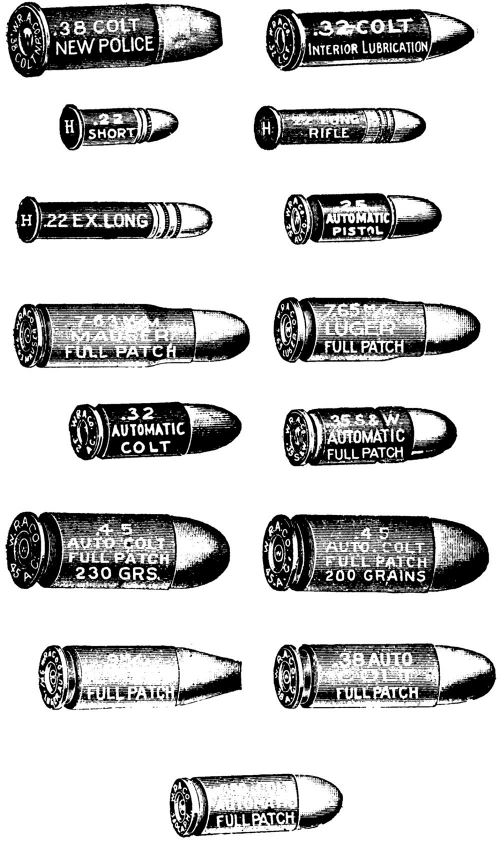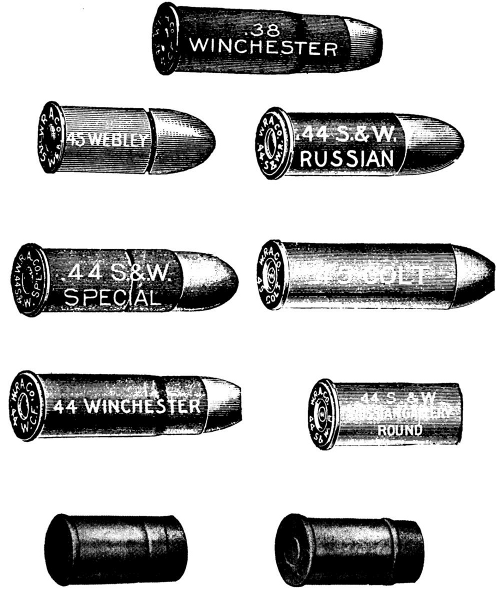The following information on pistol and revolver ammunition comes from The Book of the Pistol and Revolver by Hugh B. C. Pollard. The Book of the Pistol and Revolver is also available to purchase in print.
The smallest modern central-fire pistol cartridge is the .25 rimless automatic, used in automatic pistols and some Continental pocket revolvers. It is of necessity a smokeless powder, high-velocity load, with nickel-covered bullet either completely encased (full metal patched) or soft nosed—that is to say, with the lead core protruding at the nose, a practice that causes the bullet to expand upon hitting an object, producing a larger wound. Most metal-patched bullets are provided in both these forms.
Next comes the .32 series, which are adapted for pocket arms—ladies’ use—and the smaller calibre police weapons. Of these, the .320 or .32 Short Colt contains 9 grains of powder and a bullet of 80 grains, the popular .32 S. and W. 9 grains powder and 85 grains bullet, while the .32 Long Colt is 12 grains powder and 90 grains bullet, and the .32 Colt Police Positive and .32 S. and W. Long are each of 13 grains powder and 98 grains bullet.

The short cartridges are useful for cheap target practice, and give practically no recoil, while the long ones are suitable for longer ranges and more serious work. The increased powder charge, however, makes the recoil of a light weapon noticeable.
The popular .32 automatic of 74 grains bullet, and the military automatic cartridges for the Mauser and Luger-Parabellum, also belong to this series, as does the .32-20 W.C.F. rifle cartridge, used in some police and military revolvers. This latter cartridge, loaded with the equivalent of 20 grains black powder, is smokeless, and the metal-patched bullet is capable of exceedingly accurate work.
The odd .32-44 and similar gallery charges are now seldom used except for trick work, and are not readily attainable unless ordered in quantities direct from the makers.
The .38 series starts with the standard .38 S. and W. of 14 grains powder and 145 grains bullet, suitable to most .38 pocket revolvers. The .38 Colt Short, 18 grains powder and 130 grains bullet, Long Colt D.A., with 19 grains powder and 150 grains bullet, and the regulation U.S.A. military cartridge. The .38 S. and W. Special, 21 grains powder, 158 grains bullet, is probably the best cartridge of this calibre yet designed. The .380 Automatic, with 95 grains bullet, is the pocket weapon size; the military models of .38 Auto, 130 grains bullet, and 9 mm. Luger, of 125 grains bullet, and the .38-40 W.C.F., 40 grains of powder, 180 grains lead bullet, are the more powerful military sizes.

The .38 Special is the best target cartridge; the .380 Auto the largest pocket automatic size; but the bulk of .38 revolvers are pocket weapons, chambered for the ever-popular .38 S. and W. short, a cartridge that has never been surpassed for its purpose.
The .41 sizes are now all but obsolete, as are the .44 Webley and .44 Colt. In the latter calibre the .44 Russian was the popular load for the old break-action Smith and Wessons, but the modern models are now chambered for the .44 S. and W. Special of 26 grains powder, 246 grains bullet. The .44 Russian is still used in the .44 Colt, and is loaded with 23 grains powder, 246 grains bullet. The .44-40 W.C.F., 40 grains powder, 200 grains bullet, was long a favourite revolver cartridge, as it was used in the Winchester, Marlin, and Colt rifles and carbines; but the most celebrated of all revolver cartridges is the .45 Colt, 38 grains powder, 255 grains bullet. This was the load with which most of the world-famed Western revolver work was done, and it is still the premier favourite with ranchers, miners, engineers, etc.
What the .45 Colt is to the Western Hemisphere, the .450-455 British—the English official revolver cartridge—is to Europe, Asia, Africa, and Australasia. The short .450 is now almost obsolete, as its charge of 13 grains powder, 226 grains lead, was insufficient for stopping purposes. The modern .455-450, with cordite equivalent of 20 grains powder and 230 grains lead, is an ideal cartridge, and is the standard Bisley load.
In the automatic class there are only three .45 calibre cartridges—the .45 Auto Colt, 200 grains bullet; the .45 Auto Colt, U.S.A. Government Model, with 230 grains bullet; and the .455 Automatic Webley, British Service Model, 220 grains bullet.
In the days of black powder, the fouling produced by the charge was such that, for accurate target shooting, the weapon had to be cleaned after each discharge of six shots. With modern smokeless powder all this is done away with, and shooting is a cleaner and pleasanter recreation.
Care should be taken not to use smokeless powder cartridges in weapons designed for black. The .38 S. and W. pocket revolver can be used with smokeless, but the larger calibres, with tip-up or break-down action, were barred at Bisley as likely to blow open. All modern Webleys, Colts, and solid-frame Smith and Wessons, are designed for smokeless powder, and no automatic is made for black. For ladies’ shooting or restricted practice, where noise is undesirable, the .22 is the best calibre; the .32 for house or small pocket weapons; and the .38 or .380 for large-bore pocket weapons for self-defence.
The only target size used in England is the .455, which is also the military cartridge, and it is the only one allowed in the majority of revolver competitions at Bisley. A special flat-nosed target bullet, giving additional bearing surface in the barrel, is the most popular make; and the Webley hollow-fronted, man-stopping bullet is the best military or self-defence revolver projectile ever marketed. On hitting flesh the hollow front mushrooms, and develops all the shock of the impact within the body.
Automatic pistol cartridges are rimless, and must never be used in revolvers or pistols for which they are not designed, even though they are similar in appearance and fit the chamber of the weapon in question.
Revolver cartridges in an automatic will jam the magazine, and do not function well in the barrel.
